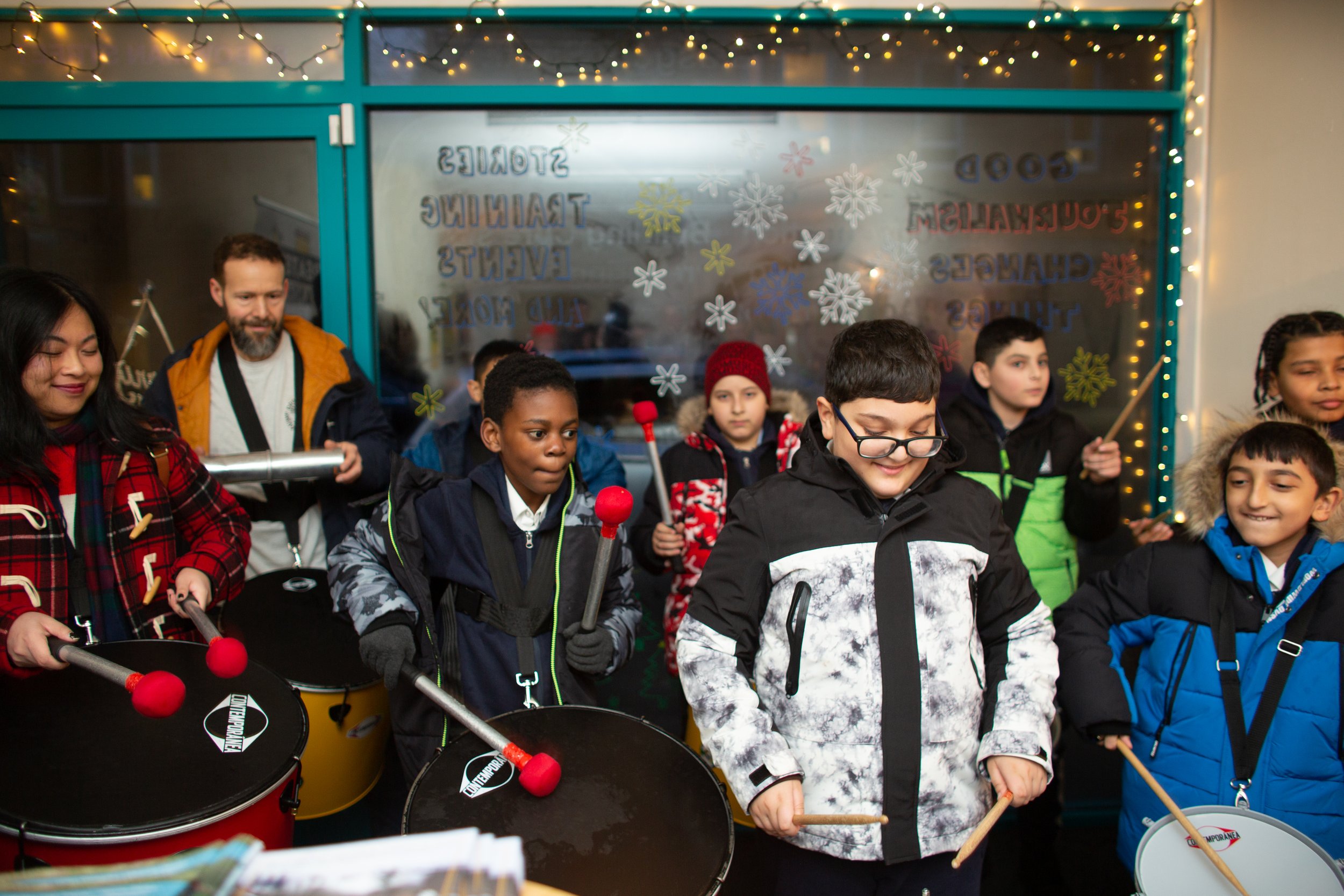Street Beats: Meet the Annette Street Drummers
The launch of The Community Newsroom was celebrated alongside Annette Street Drummers, a group of talented young kids who put on an energised performance.
Image Description: Pupils from Annette Street Primary play various types of drums in The Community Newsroom
By Rhiannon J Davies | Photo by Angela Catlin
“I couldn’t stop smiling. We were nervous before we started playing. But when we finished I wanted to do it all over again.” Awab is reflecting on his part in the performance of the Annette Street Drummers at the opening of The Community Newsroom last year.
Wrapped up in puffa jackets and bobble hats, the ten young drummers piled in through the door and set up in the cramped shop window, already steamed up with condensation. A hush fell upon both the performers and crowd before the cowbell counted in a high energy performance of latin-influenced rhythms.
All aged between 10 and 11, the group – led by Alan Bryden, Stu Brown and Hannah Lee – are a samba bateria-style street band, created by the Glad Foundation with funding from the Scottish Government’s Youth Music Initiative.
To find out more, I headed to Annette Street Primary School one Friday afternoon, entering the Victorian sandstone building as most children were rushing out the door for home. The drummers practise in the sports hall, the grey surface, painted with red and white basketball court markings. Signs for the ‘Fuel Zone’ highlight the meal deal on offer, when it doubles up as a canteen.
Tearing in there after the school bell, energy levels amongst the players are surprisingly high. Shouts reverberate, and occasional tensions flare. “They’re all just drama kings”, 10-year-old newcomer Angela confides in me. She only joined the group four weeks ago but has already picked up the most complicated rhythms.
With a drum roll on the caixa (snare) indicating things are about to begin, the chaos settles down and becomes something more like.. organised chaos.
I explain that I’m here to talk to them about the group for the magazine, and ask if there are any questions.
A hand shoots up: “Are we going to be famous?”. I say I’ll do my best. When I take my audio recorder out, there are more hands: “Are you FBI?”, “Are you going to kill me?”.
Annette Street isn’t like every other school in Scotland. Some 90 percent of pupils don’t speak English as a first language. Many are of Roma heritage, but in the group I speak to, there are also young people with Pakistani, Sudanese and Tanzanian backgrounds. The school motto is ‘Every child, every chance, every day’.
Speaking about depute headteacher, Wendy English, musician Alan Bryden says: “She knows these kids, every one of them – individually. I can't really overstate how positive I am about the relationship of all the staff and the kids here. They're just so supportive.”
He also talks about what he’s learned from tutoring the group for the past six years: “When we started, I just approached it like any other primary school drumming group, which was a mistake, because it's not like any other school. The kids here have different circumstances and backgrounds… You have to bring boundaries, but also a lot of patience and structure.”
David, Raoul, Razvana. Angela, Emil, Alishba, TJ, Leo and Awab are all at practice that day. As things get underway, they sit facing each other on wooden gym benches. Some play the surdo (bass) drums with big beaters, others take handheld percussion or play repinique (tenor drums) with sticks. They layer up multiple different rhythms, with a level of concentration most primary school teachers would give their right arm for.
The tutors take a collaborative approach, bringing some ideas for a session, but also being spontaneous depending on what’s working. Alan says this is part of what makes it special: “I think the kids here feel some ownership over what they're doing. Even though we're showing them something, they feel it’s something we've all created together on an equal level.” Stu Brown agrees: “There's more of an organic feel to it. When we go out and perform, then there's a sense of them showing how they want to present themselves to the community.”
Back at the practice, the drums have reached their crescendo. Alan counts a silent four, gives a hand signal and, as one, the group falls silent… well mostly.

